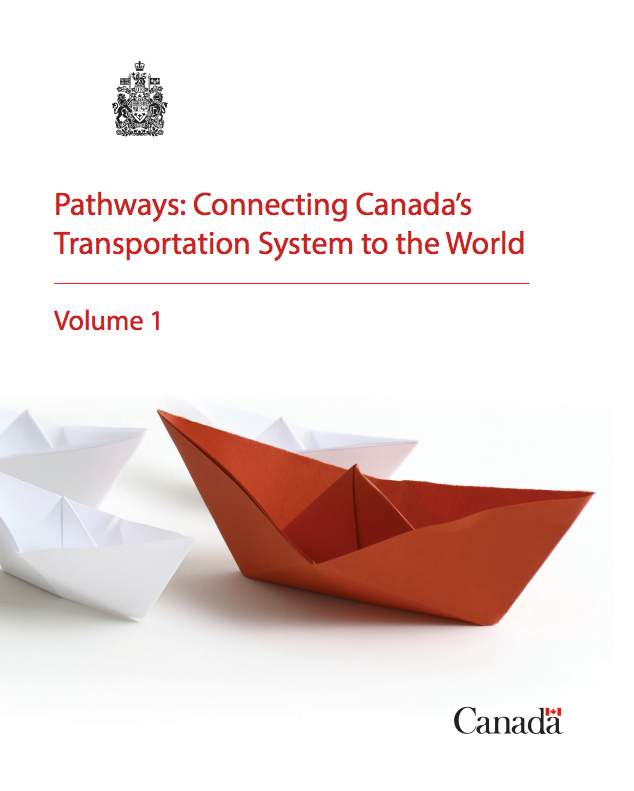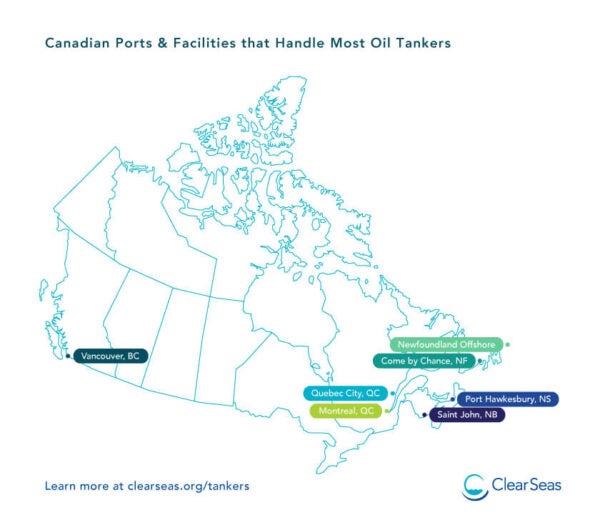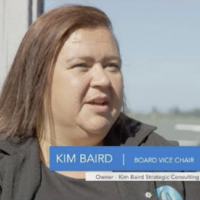Although the report covered all aspects of transportation in Canada, this digest concerns itself with the chapter on Marine Transport, particularly those aspects that deal with safe shipping practices.
Executive Summary
Clear Seas is an independent, not-for-profit organization that provides impartial and evidence-based research to inform the public and policy makers about marine shipping in Canada.Accordingly, we are providing this digest of the Canada Transportation Act Review Report, which was launched in June 2014 and completed in December 2015. The Minister of Transport tabled the report in Parliament on February 25, 2016.
Although the report covered all aspects of transportation in Canada, this digest concerns itself with the chapter on Marine Transport, particularly those aspects that deal with safe shipping practices. It is not meant to be inclusive of all the Review’s marine transportation commentary and/or recommendations, nor are the items mentioned necessarily in the same order as the original report.
Message from the Executive Director
We believe that this Report is vital to further discussion of how best to promote safe and sustainable shipping in and around Canadian waters. Of particular interest to Clear Seas are the recommendations that deal directly with the operations of the Canadian Coast Guard and with modernization options for Canada’s pilotage regime. We hope these recommendations will be a catalyst for the implementation of much needed policy and legislative change.
We encourage all industry stakeholders, the media and concerned Canadians to read the entire section on Marine Transport. It contains the latest in expert thinking on matters pertaining to economically viable and responsible shipping practices in all parts of Canada.
The federal government has indicated it will be working closely with all stakeholders, federal counterparts and with provincial, territorial and municipal colleagues in the coming weeks and months. It is also seeking to hear from industry and Canadians on the findings of the Review. We encourage comments and feedback, which may be forwarded to Transport Canada at: TC.CTAReport-RapportLTC.TC@tc.gc.ca
The Canada Transportation Act Review Report (Pathways: Connecting Canada’s Transportation System to the World) is the product of a review of the Canadian transportation system and the legal and regulatory frameworks that govern it, including the Canada Transportation Act. Consultations were held and advice received from a broad range of transportation interests, other governments, experts, and members of the public.
A recurring theme in the Report is the inseparable relationship between Canada’s international trade performance and the quality of the nation’s transportation and logistics systems. In this context Chapter 10 discusses marine shipping in general, and more specifically short sea shipping, pilotage, ports, Coast Guard operations and other marine systems. While the first four recommendations concentrate mainly on cost competiveness issues, the last two deal with improving the performance of the Canadian Coast Guard, and streamlining options for Canada’s Marine Pilotage regime.
The Canadian Coast Guard (CCG)
The Report noted that overall the Coast Guard is a first-class organization doing the best it can – with the resources available to it – in a rapidly changing maritime environment.
Currently falling within the purview of the Department of Fisheries and Oceans as a Special Operating Agency, the CCG is responsible for the safe circulation and operation of vessels in Canadian coastal and inland waters[1] It owns and operates the federal government’s civilian fleet and provides key maritime services, such as aids to navigation, waterways management, environmental response, icebreaking, search and rescue, and marine communication and traffic services.
Unlike many northern jurisdiction nations, it does not have the authority to enforce international and national laws and regulations pertaining to the sea, the environment, and sovereignty without RCMP officers present, even though CCG vessels and staff may be the best placed to respond to critical events and detect illegal activity.
In addition it is facing a number of challenges to meet its current commitments, particularly in the face of increased shipping traffic both in the country’s traditional shipping waters and now with more maritime traffic in the North. Its fleet is one of the oldest in the world (average vessel age almost 34 years) and urgently requires renewal. Major system repairs are increasing as are the number of ships out of service, with vessel days decreasing. And its icebreaking presence in the Arctic is not optimal.
However, under the National Shipbuilding and Procurement Strategy, which requires the CCG to purchase ships from Canadian shipyards, it can only replace one ship a year, at most. At that rate, the median age of the fleet will not decrease.
The Report also underscored its points by reference to other government reviews.[2] Among other things these reports expressed concerns about availability of staff to respond to marine pollution incidents, the weakened state of the Canadian oil spill regime south of the 60th parallel, and the increasingly important role the Coast Guard will need to play in the Arctic.
To deal with weaknesses and inefficiencies in the current regime, the Report recommended a strengthening of the CCG delivery model to ensure it has the necessary mandate, equipment, operations, and funding to better serve safe and sustainable shipping in all parts of the country.
To that end the Government should:
- Situate the Coast Guard to a government portfolio with which it is most closely aligned, such as the Minister of Transport;
- Give it clear oversight and enforcement responsibilities for safety, security, and environmental protection in Canadian waters;
- Have it focus on key activities such as search and rescue, environmental response, icebreaking, pilotage, navigation aids, and charting services, among others, with revenue collection where appropriate, and allowing industry to provide and be responsible for ancillary services, such as vessel traffic services;
- Conduct a review of its operations in the Arctic to ensure they are adequate to meet future challenges and harmonize with the roles of the Royal Canadian Navy and the RCMP;
- Increase its funding, provide a clear plan for accelerated fleet renewal and services, including the purchase of a minimum of one polar and two heavy icebreakers, and provision of associated operating costs;
- Provide it with flexibility in the application of the National Shipbuilding and Procurement Strategy so that, until fleet renewal is achieved, it has some discretion in leasing and procurement of foreign vessels; and
- Ensure that it has the resources to meet an enhanced mandate, and to satisfy current and future needs in respect of crisis response, fleet operations, increased traffic in all regions, interoperability with our maritime neighbours, and technology-based solutions. With regard to the latter, it requires funds to be able to invest in innovative technologies such as satellite-based navigation.
Pilotage
In Canada the Pilotage Act, has set the framework and regulations for the provision of pilotage services in Canada since 1972, with few changes since then. It establishes four separate pilotage authorities as Crown corporations responsible for designating compulsory pilotage areas in the Pacific, Great Lakes, St. Lawrence and Atlantic regions – exclusively providing pilotage services within those areas.
There is no question of the need for pilotage in bad weather, in and around ports, through locks, in challenging navigational channels, and for extra safety with respect to guiding specialized vessels such as tankers, as well as foreign vessels and crews new to Canadian waterways.
That said the Report felt that the Pilotage Act could be modernized to take into account new vessel and navigational capabilities to reflect circumstances where risk is reduced, as well as take advantage of technological advances such as electronic charting, GPS and Automatic Identification Systems (AIS), and other innovations such as shore based pilotage, tracking etc.
Canada could also reduce compulsory pilotage areas by expanding certification of vessel operators as pilots – as well as adapting the advancements in navigation system capabilities such as automation and remote piloting. This would enable experienced pilots to redeploy to service areas experiencing growth in demand for services, while minimizing risk.
In addition the Report indicated that a single national pilotage authority that can manage the convergence of technologies and streamlined processes and procedures would produce the best selection of user-supported services at the right cost. Further, as Canada looks at its emerging pilotage and ice management needs across the North, it will be important to have a national direction as well as consistent processes and procedures.
For these and other enumerated reasons it recommended that the Government of Canada:
- Immediately integrate the four pilotage authorities within one National Pilotage Board;
- Complete a full assessment of the governance framework for marine navigation services within three years; and
- Formally review compulsory pilotage areas, circumstances, and processes every three to five years, in consultation with users and the international pilotage community, taking into account new technologies and best practices – including a re-assessment of navigational safety risks.
[1] It also oversees – or where necessary takes charge of – pollution spill response operations when and where they occur.
[2] Specifically the Independent Review of the M/V Marathassa Fuel Oil Spill Response Operation; A Review of Canada’s Ship-source Oil Spill Preparedness and Response Regime—Setting the Course for the Future; A Review of Canada’s Ship-source Spill Preparedness and Response: Setting the Course for the Future, Phase II – Requirements for the Arctic and for Hazardous and Noxious Substances Nationally.




